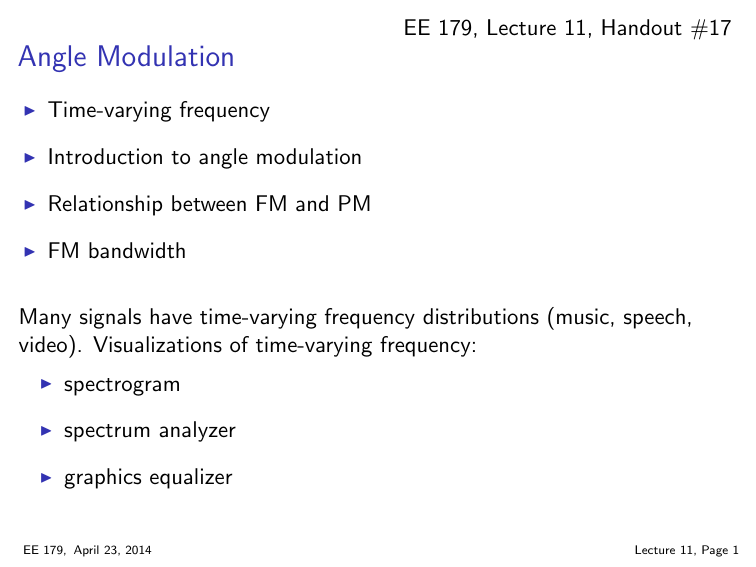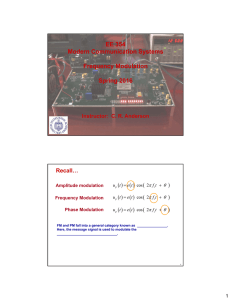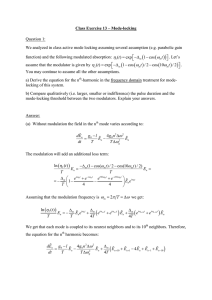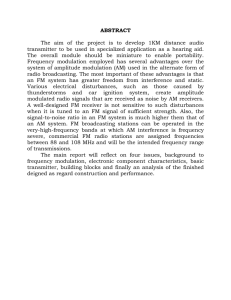Lecture #11
advertisement

EE 179, Lecture 11, Handout #17 Angle Modulation ◮ Time-varying frequency ◮ Introduction to angle modulation ◮ Relationship between FM and PM ◮ FM bandwidth Many signals have time-varying frequency distributions (music, speech, video). Visualizations of time-varying frequency: ◮ spectrogram ◮ spectrum analyzer ◮ graphics equalizer EE 179, April 23, 2014 Lecture 11, Page 1 Spectrogram This spectrogram shows a whistler in the VLF band. EE 179, April 23, 2014 Lecture 11, Page 2 Spectrum Analyzer EE 179, April 23, 2014 Lecture 11, Page 3 Spectrum Analyzer (cont.) EE 179, April 23, 2014 Lecture 11, Page 4 Graphic Equalizer EE 179, April 23, 2014 Lecture 11, Page 5 Instantaneous Frequency ◮ In general, the frequency of a signal at an instant in time depends on the entire signal (Hilbert transform) ◮ For generalized sinusoids, we can use a simpler approach. Suppose ϕ(t) = A cos θ(t) . Then θ(t) is the generalized angle. For a true sinusoid, θ(t) = ωc t + θ0 , linear with slope ωc and offset θ0 ◮ The generalized angle is not limited to [0, 2π]. Wrapping introduces discontinuities. ◮ Matlab has unwrap function to remove discontinuities. EE 179, April 23, 2014 Lecture 11, Page 6 Instantaneous Frequency (cont.) ◮ Instananeous frequency is derivative of generalized angle: ωi (t) = ◮ dθ = θ′ (t) dt By Fundamental Theorem of Calculus, Z t Z t ωi (u) du ωi (u) du = ωi (0) + θ(t) = −∞ 0 ◮ We can modulate a generalized sinusoid by using a signal m(t) to vary either θ(t) or ωi (t). ◮ In either case, the frequency of the modulated signal changes as a function of m(t). EE 179, April 23, 2014 Lecture 11, Page 7 Instantaneous Frequency (cont.) EE 179, April 23, 2014 Lecture 11, Page 8 Phase Modulation (PM) & Frequency Modulation (FM) ◮ In PM, phase is varied linearly with m(t): θ(t) = ωc t + kp m(t) ⇒ ϕPM (t) = cos ωc t + kp m(t) The instantaneous frequency is ωi (t) = dθ = ωc + kp ṁ(t) dt If m(t) varies rapidly, then the frequency deviations are larger. ◮ In FM, frequency deviation is linear in m(t): ωi (t) = ωc + kf m(t) The angle is θ(t) = EE 179, April 23, 2014 Z t ωc + kf m(t) du = ωc t + kf −∞ Z t m(u) du −∞ Lecture 11, Page 9 Relationship Between FM and PM ◮ ◮ Phase modulation of m(t) = frequency modulation of ṁ(t). R Frequency modulation of m(t) = phase modulation of m(u) du. EE 179, April 23, 2014 Lecture 11, Page 10 Generalized Angle Modulation ◮ We can vary phase using a linear transform of message signal: ϕEM (t) = A cos ωc t + h(t) ∗ m(t) Z t m(u)h(t − u) du = A cos ωc t + −∞ Note that the impulse response h(t) is causal. ◮ PM (h(t) = kp δ(t)) and FM (h(t) = kf u(t)) are special cases. ◮ We recover m(t) from phase by using inverse filter H −1 (s). E.g., for FM the inverse of integration is differention. EE 179, April 23, 2014 Lecture 11, Page 11 FM Example: kf = 2π × 105 , fc = 100 MHz Instantaneous frequency: kf m(t) = 108 + 105 m(t) 2π = 99.9 MHz fi = fc + fi,min fi,max = 100.1 MHz Is the modulated signal confined to the frequency band 99.9− − 10.1+ ? No. The bandwidth is approximately 300 KHz. EE 179, April 23, 2014 Lecture 11, Page 12 PM Example: kp = 10π, fc = 100 MHz Instantaneous frequency: kp ṁ(t) = 108 + 5ṁ(t) 2π = 99.9 MHz fi = fc + fi,min fi,max = 100.1 MHz FM modulation of m(t) is same as PM modulation of ṁ(t). EE 179, April 23, 2014 Lecture 11, Page 13 Frequency Shift Keying (FSK) The binary message can be detected using two filters tuned for the two frequencies. FSK is a historically important digital modulation scheme. The Bell 103 modem used frequencies 1070 and 1270 for originating station. EE 179, April 23, 2014 Lecture 11, Page 14 Phase Shift Keying (PSK) The binary message can be detected by correlating with sinusoids of a fixed frequency but different phases. The sinusoids are 180◦ out of phase but synchronized with the carrier. EE 179, April 23, 2014 Lecture 11, Page 15 PSK: Direct Modulation If kp = π/2 and m(t) takes on only values +1 and −1, then ϕFM (t) = A cos ωc t + kp m(t) π = A cos ωc t + m(t) 2 ( A sin ωc t when m(t) = −1 = −A sin ωc t when m(t) = 1 The figure on the previous slide corresponds to bit duration 7/fc , where fc is the carrier frequency. Phase changes of ±π are possible at the end of each bit period. The transmitter must low pass filter the PSK signal. EE 179, April 23, 2014 Lecture 11, Page 16




